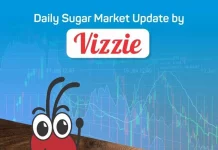July 26 to July 30, 2021
CONTRASTS
The sugar futures market in NY closed out Friday at 17.93 cents per pound for October/2021, a 24-point drop against the previous week, a little over 5 dollars per ton. All the maturities corresponding to the 2022/2023 crop in the Center-South, that is, from May/2022 to March/2023 also dropped at the same rate. Since the Brazilian currency just about stayed unchanged in the weekly accumulated, the drop for October/2021 and March/2022 was at R$30 per ton on average. The 2022/2023 crop had a slight depreciation of R$7 per ton and the 2023/2024 crop was the same as the previous week.
The freezing temperatures in the Center-South of Brazil contrast to the warm context of the sugar on the physical market. Several mills claim that they have been approached by trading companies to postpone the sugar deliveries for shipping in August while other trading companies just delay loading. These attitudes on the part of the trading houses, validated by the October/March spread, which shows a discount of nearly 7% per year, differ from the perception that the market is trying to show that we will have a shortage of sugar.
The funds have been the major players of this high, taking advantage of the cold wave and the resulting narrative about a reduced sugarcane crop due to the weather. Over a week, they have added on 27,800 lots (equivalent to more than 1.4 million tons of sugar) inflaming the market and causing serious concern for those who are short and need to pay margin calls for the unreasonable highs. Based on our survey, the set made up of those who are short (trading companies, mills, OTC providers, banks, among others) represents a drainage of the cash flow resources that has gone beyond US$2 billion.
There is a clear contrast between what the futures market wants to show and the behavior of the physical sugar market. It’s true that the market has already appraised a sugarcane crop in the Center-South as low as 540 million tons. If it takes on a smaller volume than that, the chances are the market will change price levels, also depending on other variants orbiting us, such as oil price on the foreign market, the behavior of the real against the dollar, the magnitude of the recovery of the Brazilian and global economies, to mention just a few.
Another contrasting fact is that regardless of the size of the crop of the Center-South for this year, there is consensus that the next sugarcane crop will reflect the problems suffered by the cane due to the drought and frost this season much more clearly. In other words, the prices in cents per pound on the futures market both for the 2022/2023 crop and the 2023/2024 crop, in our view, don’t reflect the risk Brazil will take from producing insufficient sugar and ethanol to meet the domestic fuel demand (clearly constructive after the pandemic) and the sugar demand on the foreign market, increasing by 1.1% per year. On top of all these factors there is India taking a path of no return when it comes to ethanol in that country and, therefore, in the near future, becoming just a residual supplier of sugar for the world.
Our fear that this bullish script won’t be fulfilled over the medium/long term lies on exogenous factors which can disrupt this setting. Itaú Bank estimates SELIC (the Brazilian federal funds rate) at 7.5% for the end of this year. So, if everything else stays unchanged, we would see the fees of NDF (Non-Deliverable Forward), a forward contract of currency with financial settlement, for future maturity providing more real per dollar sold, with a potential fall of up to 100 points in quotations in cents per pound regarding 2023/2024 (May/2023 to March/2024).
Petrobras taking so long to set the gas price in line with the foreign market is also worrisome. Today, the gap is around R$0.3000 per liter jeopardizing the arbitrage with the hydrous.
The good news is that India taking advantage of the good prices on the foreign market and in line with the subtle policy of subsidy reduction should reduce the subsidies for sugar export from the current ₹4,000 to ₹3,500 per ton, which would put the break-even point around 16.75 cents per pound, still a little below what the quotations for India’s crop (which starts next October) for next year show. Up until yesterday, India had already exported 5.3 million tons of sugar out of the 5.85 million already registered.
This week, India sold 500,000 tons of sugar at 440 dollars per FOB ton for December and January shipments. This sugar will start to be produced in October. What’s unusual about this sale, contrasting with what usually occurs, is that rarely do Indian exporters sell sugar before the announcement of the subsidy by the government. The market believes that some Brazilian trading companies involved in the acquisition of sugar would be getting ahead of a possible shortage of the product in Brazil along with an accommodation of their trading books and also providing an opportunity for making an internal sugar swap which they would receive here for ethanol production.
You all have a nice weekend.
Click here to read Episode 1
Click here to read Episode 2
Click here to read Episode 3
Click here to read Episode 4
Click here to read Episode 5
Click here to read Episode 6
Click here to read Episode 7
Click here to read Episode 8
Click here to read Episode 9
Mr. Arnaldo Luiz Correa is the Director at Archer Consulting. He is a Risk Manager with an experience of almost 30 years in the agriculture commodities market.
To get in touch with Mr. Arnaldo, write on arnaldo@archerconsulting.com.br












